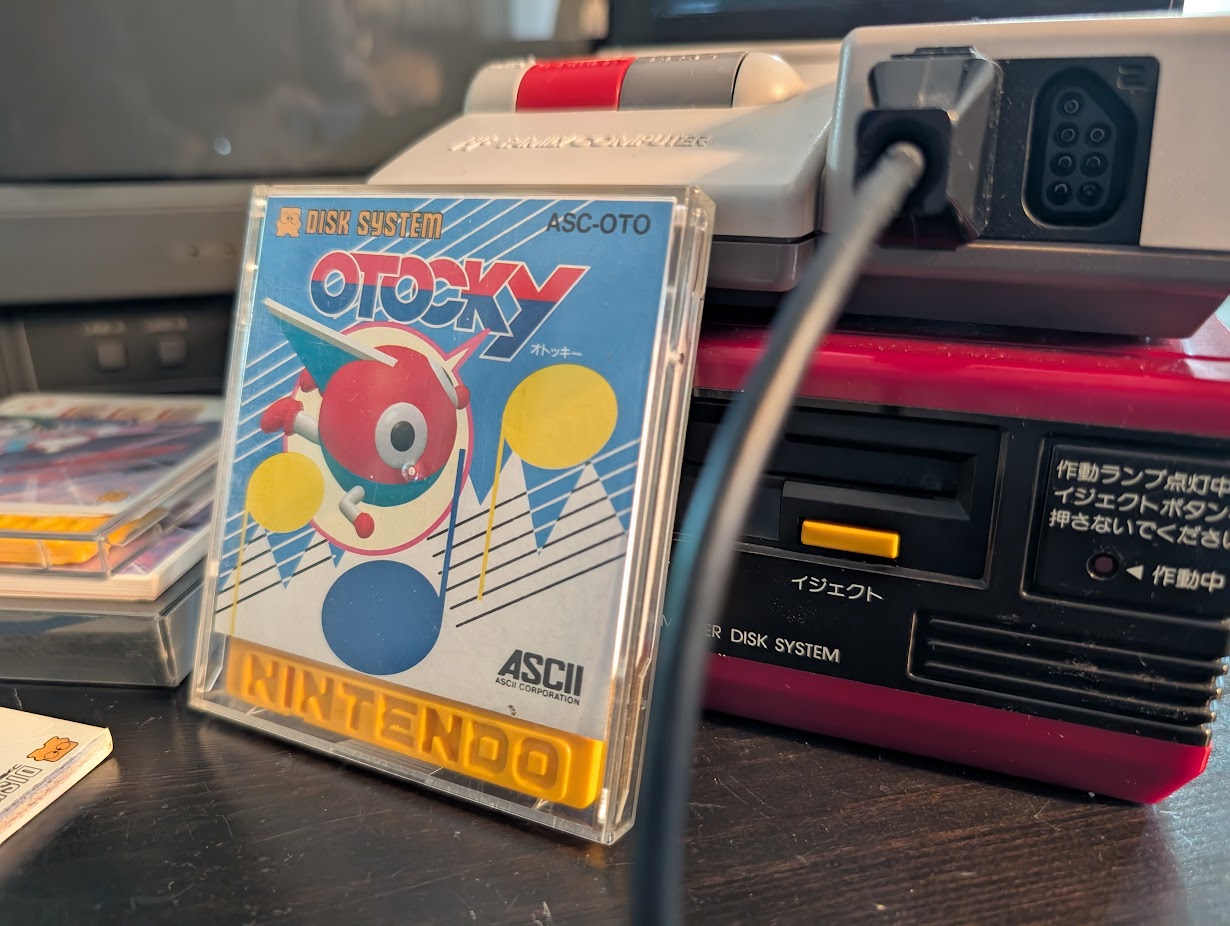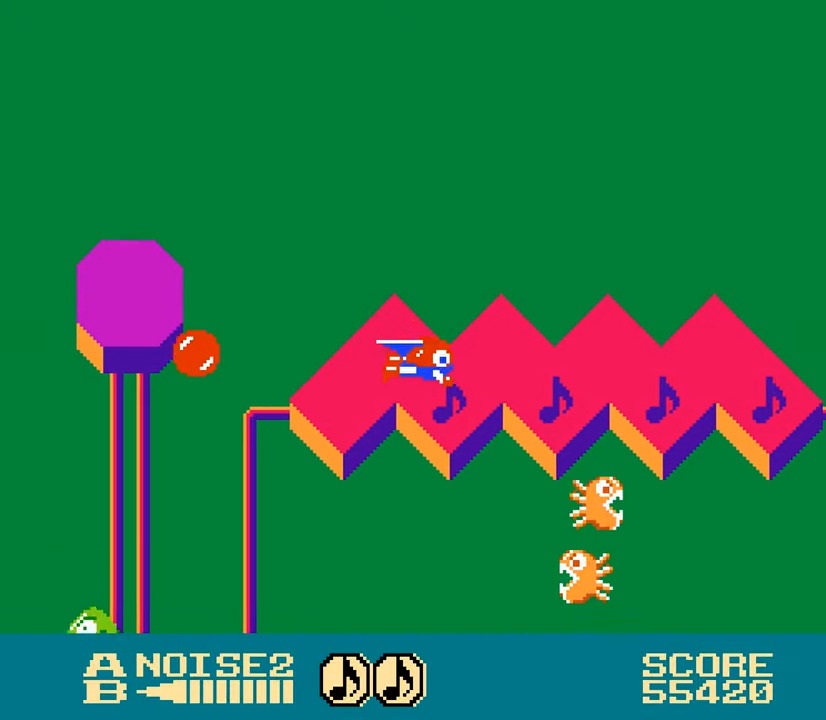GAME CLEAR No. 226 -- Otocky
video games game clear ascii corporation sedic nintendo family computer family computer disk systemOtocky (1987, Family Computer Disk System)
Developer: SEDIC
Publisher: ASCII Corporation
Clear Version: Family Computer Disk System
Clear Platform: Family Computer Disk System
Clear Date: 5/13/25

| Why should I care? |
|---|
| Otocky is wildly creative for its time and remains a fascinatingly singular music-game experience. |
Please set disk card.
For the third and hopefully final post, I will mention that I was recently in Japan. Among my goals while there was to buy lots and lots of video games and video game accessories that are hard to get at home. In particular, I was interested in the Family Computer Disk System (FDS).
Released in 1986, the Disk System is a fascinating add-on to Nintendo’s Family Computer. As its name would suggest, the FDS plays games stored on a proprietary floppy disk format. The system was introduced because its disks were cheaper to manufacture and were also writable media. This allowed for players to save their games (the lengthy The Legend of Zelda debuted on the system), but it also allowed them to fully overwrite the game software as well. This was facilitated by Disk Writer Kiosks, which Nintendo distributed to retail locations around Japan. In a country that had just banned the rental of video games, this allowed for a clever workaround.
For a variety of reasons likely including the fact that such a ban did not affect other regions, the Disk System never saw release outside Japan. Thus, its disk cards were the only physical format of Nintendo software that I had for so long been unable to play.
I accomplished my goal of purchasing the system on my first day in Osaka. The Kansai city’s Den-Den Town (Nipponbashi) is famous for its game and electronics stores, and that reputation certainly bore out in my experience. There were two game store visible from my hotel and a host of other otaku media stores mere blocks away.
The store I purchased my console from devoted the front portion of its floorspace to used video games, but the majority of their square footage (hidden behind a curtain) was dedicated to pornography. Whatever pays the bills I guess!
Having secured that bag, the task remained for me to find some software for it. I was particularly in the hunt for the subject of this post, Otocky. A few months before my trip I had become aware of the musical-synthesis shmup from 1987 was was in awe that such a string of descriptors could describe a real game. It was far from the most popular or best selling FDS game, though, so my expectations were not high for finding it.
As it happened, I would come across it mere hours later in Nipponbashi at a store called Super Potato. This particular dealer of used games had something of a negative reputation for overpricing their wares, but at least for the stuff I was interested in, I did not find that to be the case. I delightedly ask them to retrieve Otocky from behind the glass and grabbed a couple other cheaper Famicom titles as well. Consider me a satisfied customer.
Having accomplished the meat of my vintage game hunt on just my second full day in Japan was a welcome surprise, but it did put me in the position of having a greater perceived wait to finally play with my new toys. Plus, floppies aren’t exactly the most resilient of storage formats, so I was a little nervous I might mishandle the game I came all this way to get. Yes, I know I could have just made a few clicks and purchased them on eBay, but the hunt is part of the fun!
Even likelier to malfunction was the Disk System itself. The poor FDS actually has a 100% failure rate because of the belt used to rotate the disks. It’s made of inexpensive rubber and simply completely degrades over time. While I wouldn’t have minded the convenience of having bought one that had been repaired, I was also kind of hoping to have the opportunity myself. I’ve never been much of a DIY repairman, but I’ve resolved recently to try to push myself a bit in that direction. A purely mechanical fix like replacing a drive belt seemed like a perfect place to start.
When I go the device home, I discovered I was in “luck” and the belt had indeed not been replaced. Bits of it were strewn about the interior of the console and sticky residue remained on the gears it once turned. I’ll spare you the details of the repair, but despite some false starts (including breaking one of the gears clean in half), I did manage to get the thing working again with the help of online guides (and epoxy). I felt a swell of pride at having done it, and I hope it’s just the first step on my way toward becoming self-sufficient at vintage hardware repair. To the extent that this blog is in some ways a video game “diary,” I really do hope to reread this post with a wealth of repair experience one day.
With all that done, I finally put Otocky in the slot and smiled as it came to life.
Roughly 800 words in, let’s talk about the game, shall we?

As aforementioned, Otocky is a shoot them up starring the titular flying creature who is some kind of musical warrior. Some bad music guys have appeared in his world, and it’s his job to bring peace back to the land. I’m paraphrasing somewhat cheekily here, but that is more or less what I gathered from a machine translation of the story in the manual.
Anyway, shmups were a dime a dozen back in those days, but what makes Otocky special is its musical slant. As the little guy flies through each stage of the game, he can shoot two red and blue balls. These act as his weapon. They also return to him and are used to grab the musical notes that are scattered throughout each stage and dropped by enemies — collecting enough of these will cause the stage boss to appear.
Most importantly, Otocky’s weapon can be fired in eight directions, each of which corresponds to a musical note in the key of the current background music. This makes him a flying soloist. Taking advantage of the extra sound channel provided by the Famicom Disk System means he can play his tune without overriding any of the channels of the BGM. You don’t have to worry that this will be cacophonous either, as Otocky’s shots are quantized to the beat of the music, so no note is ever off tempo.
Otocky starts each stage with his weapon set to sound like a specific instrument, but the instrument changes when he collects powerups (as does the weapon’s range, speed, etc.). This makes for a pleasing mix up as Otocky’s power creeps.
All those factors combined mean that every playthrough of any stage of Otocky involves playing a new tune no one has ever heard before. Pretty neat! Now, obviously we’re not talking about masterpieces here since the priority is defeating enemies and surviving, but it’s still so cool and so unlike anything that existed at the time.
The stages themselves range from soothing to maddening, but the colorful graphics, stylish backgrounds, and catchy music make them worth playing through. I was bound by the terms of this blog series to do so regardless.
Knowing that the opportunity for less stressful creativity existed, the devs also kindly included a “BGM” mode in which there are no enemies and you can play to your heart’s content through the stages you have cleared. You can change instruments on the fly and jam in the peaceful world you helped create.
When you’ve cleared the majority of the game — or all of it? I don’t remember — you unlock a full-fledged music composition mode. It’s really remarkably sophisticated and works in much the same way that modern music creation software does. When you’re done, you can test out your tune in any level of the game and solo over it with the ever-faithful Otocky. Thanks to its floppy disk format, you can even save the music you painstakingly composed for future enjoyment or modification. I haven’t played much with this mode, having no real composition chops, but I’m really in awe of it. It’s such a creative and singular vision for any time, let alone 1987.
That vision, by the way, came from one Toshio Iwai, more famous for creating the lovely Electroplankton for Nintendo DS. Cool guy.
I’m awfully glad I had the good fortune to bring little Otocky home with me from Japan. The game may not be an all-time classic like Zelda or Metroid, the Nintendo giants that debuted on floppy disk, but it’s so far out on its own it’s hard to believe. This is why I’ll never stop plumbing the depths of this medium, man. People have committed such awesome stuff to every corner of it.